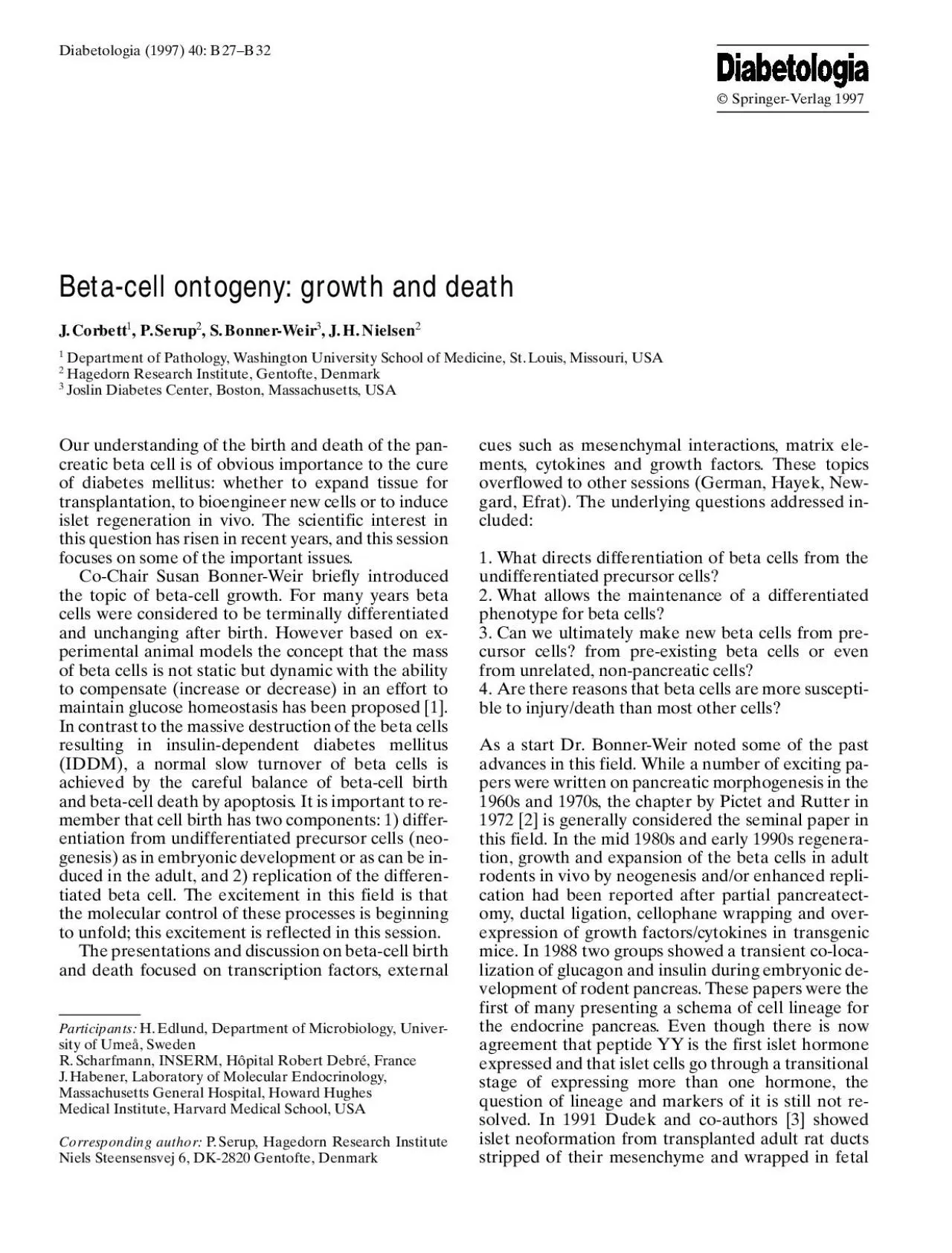

SpringerVerlag1997 Participants gutmesenchymeshowingthatadultpancreaticductscouldstillundergodifferentiationintoisletsOverthesesameyearstranscriptionfactorshavebeenidentifiedinthepancreaswithvaryi ID: 937633
Download Pdf The PPT/PDF document "Ourunderstandingofthebirthanddeathofthep..." is the property of its rightful owner. Permission is granted to download and print the materials on this web site for personal, non-commercial use only, and to display it on your personal computer provided you do not modify the materials and that you retain all copyright notices contained in the materials. By downloading content from our website, you accept the terms of this agreement.
Ourunderstandingofthebirthanddeathofthepan-creaticbetacellisofobviousimportancetothecureofdiabetesmellitus:whethertoexpandtissuefortransplantation,tobioengineernewcellsortoinduceisletregenerationinvivo.Thescientificinterestinthisquestionhasriseninrecentyears,andthissessionfocusesonsomeoftheimportantissues.Co-ChairSusanBonner-Weirbrieflyintroducedthetopicofbeta-cellgrowth.Formanyyearsbetacellswereconsideredtobeterminallydifferentiated Springer-Verlag1997 Participants: gutmesenchyme,showingthatadultpancreaticductscouldstillundergodifferentiationintoislets.Overthesesameyearstranscriptionfactorshavebeenidentifiedinthepancreaswithvaryingdegreesofrestrictiveexpressiontospecificcelltypes.Theabilitytooverexpressorªknockoutºgenesopenednewdoorsofinvestigationinthisarea.The1994pub-licationfromtheEdlunds[4]onthemicewithnullal-leleofthetranscriptionfactor,pdx-1wasastartlingandimportantmilestone(seebelow).Thatpaperhasstimulatedrenewedinterestinthefield.HelenaEdlund:IsletcellontogenyHelenaEdlundpresentedtheresultsofaseriesofex-perimentsaimedatdeterminingtheroleofthehome-odomaintranscriptionfactorsPDX-1andISL1inpancreaticdevelopment.PDX-1deficientmice.Atpresent,verylittleisknownaboutthesourcesandthenatureoftheinductivesig-nalsthatcontrolthedevelopmentofthepancreasandthegenerationoftheindividualcelldifferentiatedtypes.Greatprogress,though,hasbeenmadeintheidentificationoftranscriptionfactorsinvolvedinpan-creaticdevelopment.Thestudyofcell-specificregu-lationoftheinsulinandsomatostatingeneshaveledtothecloningofcDNAsencodingmouse[5]andrat[6]homologuesofthehomeodomainproteinPDX-1(alsoknownasIPF1,IDX-1STF-1,IUF-1,andGSF).HelenaEdlundreportedtheresultsofanele-gantseriesofexperimentscombininggenetargetingandinvitrocultureofpancreaticexplants.PDX-1ex-pressionisinitiatedintheepitheliumoftheprimitiveforegutinarestrictedareadeterminedtodevelopintothepancreas.Whenthisexpressionisabrogatedbygenetargetingthemutantpupssurvivefetaldevel-opmentbutdiewithinafewdaysafterbirth[4].Re-markably,thepupslackthepancreascompletely.Thegastrointestinaltractandallotherinternalor-ganswerenormalinappearance.Othergroups,how-ever,havereportedreducednumbersofendocrinecellsintheduodenumandtheantralpartofthestom-ach.Furtheranalysisrevealedthattheearlyinductiveeventsleadingtotheformationofthepancreaticbudsandtheappearanceoftheearlyinsulinandglu-cagoncellsoccurinPDX-deficientembryos.How-ever,thesubsequentmorphogenesisoftheepithe-liumandtheprogressionofdifferentiationarearrest-edinPDX-1deficientembryos.ItwasalsoshownthatthepancreaticepitheliuminthePDX-1mutantsisunabletorespondtothesignal(s)derivedfromthemesenchymewhichnormallypromotespancrea-ticmorphogenesis.Takentogether,thesedatapro-videevidencethatPDX-1actscell-autonomouslyandthatitisadefectinthepancreaticepitheliumthatresultsintheapancreaticphenotype.ISL1deficientmice.Previousanalysis,byEdlund,ofcis-elementsandtransactingfactorsresponsibleforthecell-specificexpressionoftheinsulingeneresult-edintheisolationofacDNAencodingIslet-1(ISL1),aLIM-homeodomainproteincapableofin-teractionwithaninsulingenecis-element.ThegreatsimilarityofISL1withtheCaenorhabditiselegansproteinsmec-3andlin-11,whichcontrolcellfatede-cisions,suggeststhatISL1couldbeinvolvedinthespecificationofthepancreaticendocrinecelllineage.Dr.EdlundshowedthatembryonicexpressionofISL1isinitiatedsoonaftertheendocrinecellshaveleftthecellcycle.ISL1isalsoexpressedinthemes-enchymalcellsthatsurroundthedorsalbutnottheventralevaginationofthegutendodermthatto-gethercomprisethepancreaticanlage.Dr.EdlundreportedanalysesofacinarandisletdifferentiationinmicelackingISL1.InadditiontodefectsoutsidethepancreasISL1mutantembryosdonotformthedorsalpancreaticmesenchymeandthereisafailureofexocrinecelldifferentiationinthedorsalbutnottheventralpancreas[7].Inaddi-tion,thereisacompletelossofendocrinecellsinbothportions.
Importantly,exocrine,butnotendo-crine,celldifferentiationinthedorsalpancreascanberescuedbyprovisionofmesenchymederivedfromwild-typeembryos.Thesourceofmesenchymeisnotrequiredtobepancreaticasliverandlungde-rivedmesenchymealsorescuesexocrinecelldifferen-tiation.TheseresultsshowfirstthatISL1byvirtueofitsrequirementfortheformationofdorsalmesench-yme,isnecessaryfordevelopmentofthedorsalexo-crinepancreasandsecondthatISL1functionisre-quiredinpancreaticendodermalcellsforgenerationofendocrinecells.Duringthediscussionitwasaskedwhetheranytranscriptionfactorregulatingexpressionofadhesionmoleculeshasbeenidentified.Dr.GermanansweredthatPax-6regulatesN-CAMandN-cadherinexpres-JensHùiriisNielsen:Beta-cellgrowthfactorsandtheirreceptorsJensHùiriisNielsengaveanoverviewofbeta-cellgrowthfactorsandtheirreceptorswithspecialem-phasisongrowthhormone(GH)andprolactinRoleofGHandPRLinbeta-cellgrowth:Growthhor-mone(GH)isconsideredasadiabetogenichormonesinceitinducesinsulinresistanceandhyperglycaemiabycounteractingtheeffectofinsulinonglucoseme-tabolism.Thereis,however,evidenceforadirecttrophiceffectofGHonthepancreaticbetacells.Cul-tureofratisletsinthepresenceofGH,PRLorpla-centallactogen(PL)wasfoundtostimulatebothJ.Corbettetal.:Beta-cellontogeny:growthanddeathB28 DNAsynthesisandinsulinproduction.NotonlyarethecirculatinglevelsofPL,PRLandplacentalGHelevatedduringpregnancybutalsotheexpressionoftheirreceptors(R)intheislets.Thus,bothGH-RandPRL-RmRNAlevelsareincreasedtwotofive-foldinthepancreasfrompregnantrats.Theexpres-sionofthereceptorsisunderdifferenthormonalreg-ulation.WhereastheGH-Risupregulatedbygluco-corticoidsandprogesterone,thePRL-RismarkedlyupregulatedbyPRLandGH[8].TheeffectofGHorPRLonadulthumanisletsismuchlessthanonratislets,probablybecauseofthelowlevelofreceptorexpression.Thisobservationre-flectsthespeciesandagevariationofthediabeto-geniceffectofGH.ThusGHisnotdiabetogenicintheintactrat,pregnantdogsandpuppiesbutisdiabe-togenicintheadultdogandman.Moleculardissec-tionoftheGH-Rhasrevealedthatdistinctdomainsofthecytoplasmicpartarerequiredforvarioussig-nallingpathways.Thustheproximalprolinerichdo-main(box-1)isnecessaryforbindingandactivationofthetyrosinekinaseJAK-2,whichphosphorylatesthesignaltransducersandactivatorsoftranscriptionproteinsSTAT-1and3,bothinvolvedinactivationofthefosgeneandtherebyincellproliferation.Thedistalpartofthecytoplasmicmoietycontainsthreedistincttyrosineresidueswhichuponphosphoryla-tioncanbindSTAT-5,whichissubsequentlyphos-phorylated,probablybyJAK-2,andtranslocatedtothenucleuswhereitbindstospecificDNAsequencesintheinsulingene.Possibleroleofpreadipocytefactor-1inbetacellgrowth:IncontrasttomanyothertissuestheeffectofGHonisletsdoesnotseemtobemediatedbyinsu-lin-likegrowthfactor(IGF)-1.This,however,doesnotexcludethatotherautocrinegrowthfactorsareinducedbyGHinthebetacell.InordertoidentifygenesinthebetacellwhichareupregulatedbyGH/PRLacDNAlibraryconstructedfromhGHstimu-latedneonatalratisletswasscreenedwithcDNAprobesfromunstimulatedandhGHstimulatedislets.ClonesonlyhybridizingwithhGHstimulatedprobewereisolatedandsequenced.Oneparticularclonehomologoustomousepreadipocytefactor-1(Pref-1)andhumanfetalantigen-1(FA-1)wasfurtherinvesti-gated.Theproteincontainssixepidermalgrowthfac-tor(EGF)likerepeats,similartotheteinsNotchanddeltawhichareinvolvedincellfatedetermination.BothinmanandinratFA-1isexpres-sedinmostepithelialcellsearlyindevelopmentbutbecomesrestrictedtothebetacellatalaterstage.InadulthumanbetacellsFA-1immunoreactivityislocatedintheinsulingranules.ThefunctionofPref-1/FA-1isstillunknownbutitmaybespeculatedthatPref-1participatesincell-cellinteractionduringearlydevelopment,inanalogywiththedelta-Notchinteractioninpreventingterminaldifferentiationandallowingcellproliferation.WhetherPref-1hassucharolemustawaitfurtherstudies,butthecorrelationbetweenbetacellprolif-erat
ionandPref-1expression,i.e.latefetalandneo-natalislets,isletsfrompregnantratsandisletsex-posedtoGHandPRLinvitro,supportthishypo-thesis.ThequestionifPref-1couldbeamarkerforductprecursorcellswasdiscussed.Theneedforsuchmarkerswasstressed.NewgaardraisedthequestionwhetherdexamethasoneinducedductalproliferationwasmediatedthroughaGH-receptordependentmechanism.Itwasstatedthathypopituitarismdoesnotleadtodiabetes,arguingagainsttheideaofGHasabeta-cellgrowthfactor.AcommenttothisargumentwasthatahighprevalenceofdiabetesisobservedintheLaronsyndrome(dwarfismcausedbyGH-recep-tormutations).Dr.HalbanaskedwhetherPref-1wassialylatedbutthiswasnotknownatpresent.RaphaelScharfmann:Similaritiesbetweenbetaandneuronalcells:possiblecluestounderstandbeta-celldevelopmentAdiscussionofthemechanismsofdifferentiationofbetacells,andthesimilaritiesofbeta-celldifferentia-tionwithneuronalcellswaspresentedbyRaphaelScharfmann.Sinceneuronalandbetacellssharetheexpressionofalargenumberofproteins,thepossibi-litythatsimilarmechanismsregulatedifferentiationofbothcelltypeswasdiscussed.Dr.Scharfmannfo-cusedonthreemainquestions:1)doneurotrophins,whichareimportantforneuronalcellmaturation,participateinbeta-celldifferentiation;2)dothetran-scriptionalmechanismsthoughttobespecificforneuronalcells,functioninbetacells;3)doendocrinepancreaticcellsdevelopbyadefaultmechanismasisthoughttooccurduringneuronaldifferentiation.Neurotrophicfactorsandbetacells:Thesolubleneu-rotrophicfactorsnervegrowthfactor(NGF)brainderivedneurotrophicfactors(BDNF)andneurotro-phin-3(NT3)participateingrowthandsurvivalofneuronalcells.TheseneurotrophinsbindtotheTrkfamilyofcellsurfacereceptors(Trk-A,Trk-B,Trk-C).TheratinsulinomaINS-1cellsexpressafunction-alhighaffinityNT3receptorTrk-C,andNT3stimu-latesCainfluxinthesecells.ThesefindingssuggestthatNT3maymodulatebeta-cellphysiology.NGFreceptors(Trk-A)arealsoexpressedonISN-1cellsandonadultratbetacells.Duringembryogenesisim-matureductularcellsthatdifferentiateintobetacells,expressNGFreceptors[9].Inaddition,evidencewaspresentedthatfetalratbetacellsexpressNGFrecep-torsfollowinga7dayculture.Inaddition,NGFisalsoproducedbymesenchymewhichsurroundsislets,thusNGFmayactonislets.InhibitionofNGFrecep-torsignallingusingtheselectiveinhibitorK252,J.Corbettetal.:Beta-cellontogeny:growthanddeathB29 attenuatesisletmorphogenesis,implicatingNGFinisletdevelopment.Transcriptionalmechanisms,thoughttobeneuronalcellspecific,arefunctionalinbetacells:isanegativeregulatorofneuronalfatethatisknowntosilencespecificneuronalgenesinnon-neuronalcells.However,inbothPC12andINS-1cellsthemRNAexpressionandfunctionalactivityofNRSF/RESTisabsent.Thisisalsothecaseinthreeaddition-alinsulinorglucagonproducingcelllines.Genesex-pressedinbothneuronalandbetacells,includingthesodiumchanneltypeII,dopamineneurofilament,andglutamatereceptors,areknowntoberepressedbyRESTinnon-neuronalcells.Thesestudies[10]supportacommonmechanismoftran-scriptionalregulationinbetacellsandneuronalcells,andthistranscriptionalregulationmaybeofimpor-tanceforbetacelldevelopment.Doendocrinecellsdevelopbyadefaultmechanism?Dr.Scharfmannpresentedevidenceforadefaultpathwayinpancreaticendocrinedevelopment.Dur-inginitialdifferentiation(E10-E12),thefirstimma-tureinsulin-expressingcellsdevelop(expressingbothinsulinandglucagon,butnotGLUT2);how-ever,thesecellsdonotassociatetoformislets.Dur-ingasecondtransition(E13-E20),thenumberofma-tureinsulincontainingcells(glucagonnegativeandGLUT2positive)increaserapidlyandthesecellsformislets.Itiswellestablishedthattheinitialdiffer-entiationrequiresthepresenceofmesenchyme;how-ever,Scharfmannprovidedevidencethatthesecondtransitionofbetacellsoccursbymesenchyme-inde-pendentmechanisms.E12.5pancreaticepitheliagrowninthepresenceofitssurroundingmesenchymeresultsinfulldifferentiationoftheexocrinecompo-nent.However,theendocrinecellsdeveloppoorl
yandareimmatureasjudgedbyco-expressionofinsu-linandglucagonandlackofGLUT2expression.Incontrast,intheabsenceofmesenchyme,exocrinetis-suedevelopspoorlywhileendocrinecellsincrease.Theseendocrinecellsdonotco-expressinsulinandglucagonbutdoexpressGLUT2andformislet-likeaggregateswithglucagon-producingcellsinthepe-ripherysurroundingacoreofinsulin-producingcells.ThesefindingspromptedDr.Hayektosuggestthatthiseffectofmesenchymemayexplainwhyhisgroupfoundlessisletdevelopmentwithincreasingamountsofmesenchymetransplantedwithhumanfetalislet-likecellclusters(ICCs).Importantly,thesefindingssuggestthatmesenchymemayexertarepressiveroleonthedevelopmentofpancreaticendocrinetissue.Thus,pancreaticisletsmaydevelopbydefault,i.e.intheabsenceofasignalendocrinetissuewilldevelop,whileinthepresenceofasignal(mesenchyme)endo-crinedevelopmentisretardedandexocrinetissuede-velops.Thedifficultyinremovingallofthemesenchymewasacknowledged,butonthebasisofvimentinamountstoonly2%ofthemesenchymewhichre-mainedonthesebuds/explants.Howeverthemediadidcontainserumsotherewassomegrowthofthestrippedepithelium.Dr.NewgaardaskedifapossibleeffectofmesenchymeonRESTexpressionhadbeeninvestigated,butthiswasnotyetthecase.JoelHabener:Roleoftranscriptionfactorsinbeta-cellturnoverandinsulingeneregulationAtranscriptionfactorhypothesiswasproposedbyJoelHabenerasapotentialmechanismcontributingtotheimpairedinsulinproductionandreducedbeta-cellmassmanifestedinnon-insulin-dependentdia-betesmellitus(NIDDM).Theworkingmodelimpli-catestwotranscriptionfactors,PDX-1andC/EBPhavingopposingfunctionsintheregulationofinsulingeneexpression,thedifferentiationandprogrammedcelldeath(apoptosis)ofbetacells.inhibitsinsulingenetranscription.basicleucinezipper(bZIP)transcriptionfactor,aso-calledearlyresponseproteininducedbycellularstressdownregulatesinsulingeneregulationandmaybeinvolvedasanupstreameffectoroftheapop-tosispathway.Severalsequencesintheinsulinpro-moterbindrecombinantc/EBPwhenanalysedinDNaseIfootprintinganalysis.Afunctionalroleforisindicatedbydatafromtransienttransfec-tionsofTC6cellsinwhichexpressionofaninsulinreporterconstructisinhibitedbyco-transfectedC/.Incontrast,whentheexperimentisperformedinnon-beta-cellssuchasBHKandHeLainsulinpro-moteractivityisstronglyinduced.Theseapparentparadoxicaleffectsmightbeexplainedbytheselec-tivepresenceofPDX-1intheTC6cellsandsuggestthatsomehowC/EBPinterfereswiththefunctionofPDXontheinsulinpromoter.TheinhibitionseeninTC6cellsdoesnotappeartobemediatedthroughdirectDNA-bindingtotheinsulinpromoterasco-transfectionofCHOP,adominantnegativeinhibitorofC/EBPDNA-binding,failedtoabrogatetheef-fectofC/EBP.Rather,Habenersuggestedthatin-teractionofC/EBPwithE47,anotherinsulingenetranscriptionfactor,throughtheleucinezipperspre-sentinbothfactorsdisruptedthesynergybetweenPDX-1andthehelix-loop-helixIEF-1ofwhichE47isacomponent.AntibodiestoC/EBPimmunopre-cipitatedE47fromTC6nuclearextractsshowingadirectprotein-proteininteraction.PDX-1andC/EBPinªglucosetoxicityº.Itiswellre-cognizedthatchronichyperglycaemiaofNIDDMim-pairsinsulinproductionandsecretion,aphenomenonreferredtoasªglucosetoxicityº.ThisimpairmentJ.Corbettetal.:Beta-cellontogeny:growthanddeathB30 maybeaconsequenceofchronichyperglycaemiaontheexpressionofPDX-1andC/EBP.Anumberofmodels,invitroandinvivo,wereanalysedforexpres-sionofPDX-1andC/EBP.Insulinomacellsgrownlongterm(HIT,severalweeks)atelevatedglucoselevels(25mmol/l)orshortterm(INS-1,72h)exhibitprogressiveinductionofC/EBPandinhibitionofPDXexpression.Similarlyinvivomodelsofchronichyperglycaemia,the12-week-oldZuckerfattydia-betic(ZDF)ratandthehyperglycaemicrat4weeksafterpartialpancreatectomy,haddecreasedPDX-1andincreasedC/EBPexpression.Habenerpro-posedthatchronichyperglycaemiaactsasametabol-icstresstobetacellsresultingintheinductionoftheexpressionofC/EBPandtheconsequentimpair-mentofinsulingeneexpressio
n.ThemechanismsthroughwhichchronichyperglycaemiainhibitPDX-1expressionremainunknown.Anadditionalcompo-nentofthesestudiesistheimplicationthatchronichyperglycaemiamayimpairneogenesisandacceler-ateapoptosisofbetacellsviaeffectsontheexpres-sionofPDX-1andC/EBPcontributingtoareduc-tioninbeta-cellmass,acharacteristicoccurrenceinsevereNIDDM.DuringthediscussionitwasmentionedthataC/EBPfamilymemberwasrecentlyfoundtobeactivat-ingthetranscriptionoftheC.elegansapoptosispro-motingfactorsced3andced4.Theroleofsurvivalfactorssuchasbcl-2familyorNGFwasdiscussed.Additionally,thedirecteffectsofglucoseconcentra-tionsonbindingofPDX-1toinsulinpromoterwereJohnCorbett:Cytokinemediatedbeta-celldamageIntheendofthissession,findingswhichsupportaroleforcytokine-inducedbeta-celldamageandnewstudiesonthemechanismsofcytokinemediatedbeta-celldestructionwerepresentedbyJohnCorbett.Alargebodyofevidencesupportsthedirectroleforcytokine-induceddamageasonemechanismleadingtobeta-celldestructioninautoimmunediabetes.Re-centstudiesbyUngerandco-workerssuggestthatcy-tokine-inducedbeta-celldamagemayalsoparticipateinbeta-celldamageorªburn-outºinobesitymodelsofNIDDM(seesectionsonfattyacidsandbeta-cellDocytokinesmediatebeta-celldamage?Mandrup-PoulsenandNerupfirstshowedin1985thattreat-mentofratisletswithinterleukin-1(IL-1)resultsinaninhibitionofinsulinsecretionthatisfollowedbyisletdamageafterprolongedexposures(4±6days);reviewedpreviously[11].Theseinitialstudiespro-videdthefirstevidencethatcytokinescoulddirectlyinhibitthefunctionofbetacells.Recentstudiesindi-catethatthemechanismbywhichIL-1mediatesbeta-celldamageisaresultofinduciblenitricoxidesynthase(iNOS)expressionandtheincreasedpro-ductionofthefreeradicalnitricoxide.IsletcellularsourceandcytokinerequirementsforiNOSexpression.Animportantquestionconcerningthespecificityofcytokine-inducedisletdamageistheisletcellularsourceofiNOS.We(Corbettetal.)haveshownbyimmunohistochemicalco-localizationthattreatmentofratisletswithIL-1resultsintheex-pressionofiNOSbyinsulincontainingcells,andthatnon-insulincontainingcellsdonotexpressthisen-zyme[12].ThesefindingssupportthehypothesisthatIL-1-inducedisletdamageismediatedbyselec-tiveexpressionofiNOSbybetacells.Thecytokinerequirementsforbeta-cellexpressionofiNOShavebeenexamined.IL-1issufficienttostimulateiNOSexpressionbyratbetacells,whileacombinationofIL-1andinterferon-)arerequiredtostimu-lateiNOSexpressionbyNODmouseandhumanbetacells.Mechanismsofcytokine-inducedbeta-celldamage:Cytokine-inducedbeta-celldamageismediated,inpart,bynitricoxide-inducedinhibitionofmitochon-drialglucoseoxidation(specificallytheKrebscycleenzymeaconitase,andtheelectrontransportchaincomplex1and2),andDNAdamage.DNAdamagemaybemediatedbybothnitricoxide-dependentand-independentmechanisms,whileIL-1-inducedinhibitionofmitochondrialfunctionappearstobeas-sociatedwithnitricoxide-inducediron-sulphurcen-tredestructionoftheindicatedenzymetargets.ThefreeradicalspeciesthatmediatesIL-1-inducedbeta-celldamagehasbeencontroversial.Nitricoxide,oxy-genradicals,and/orperoxynitrite(producedfollow-ingtheinteractionsofnitricoxideandsuperoxide)havebeenimplicatedinbothIL-1andIL-1+IFN-inducedbeta-celldamageinratandhumanislets.Currentstudiesindicatethathumanandratisletsareequallysensitivetoperoxynitritewhileratisletsaremoresensitivetonitricoxidethanhumanislets.Thenitrogenoxidespeciesthatmediatesbeta-celldamageandthesourceandtypeofoxygenradicalsthatareproducedbybetacellsinresponsetoIL-1haveyettobeidentified.Roleofcytokine-inducedbeta-celldamageinthede-velopmentofautoimmunediabetes:ResidentisletmacrophagesarebelievedtobeanisletcellularsourceofIL-1.TreatmentofratisletswithTNF+LPS,aconditionknowntoactivatemacrophages,stimulatesiNOSexpression,nitriteformation,andinhibitsglucose-inducedinsulinsecretion.TheIL-1receptorantagonistprotein(IRAP)completelypre-ventsTNF+LPS-inducedinhibi
tionofinsulinse-cretionandattenuatesiNOSexpressionandnitricoxideproductionbyratislets.ImmunohistochemicalJ.Corbettetal.:Beta-cellontogeny:growthanddeathB31 analysisrevealsthatTNF+LPSstimulatetheex-pressionofiNOSbyinsulinpositivecellsandasecondpopulationofcellsbelievedtoberesidentisletmacrophages.IRAPcompletelypreventsTNF+LPS-inducediNOSexpressionbybetacellsbutdoesnotinhibittheexpressionbyresidentisletmacrophages[12].Thesenewfindingsindicatethattheactivationofalimitednumberofresidentisletmacrophages(approximately10±15/islet)resultsinthereleaseofIL-1,andthatthelevelsofIL-1pro-ducedinthemicroenvironmentoftheisletaresuffi-cienttostimulateiNOSexpressionbybetacells.Thus,residentmacrophageactivationmaybeonepotentialinitiationeventthatstimulatestheinitialdestructionofbetacells.FuturedirectionsandrecommendationsTheChairsandrapporteursofthissessionhavese-lectedthefollowinglistofrecommendationsastopicsforfuturelinesofinvestigation:Identificationofthesourcesandnatureofthein-ductivesignalsthatcontrolspancreasmorphogenesisandcytodifferentiation.Identificationandfunctionoftranscriptionfactorsinvolvedinbeta-celldevelopment.Identificationofanisletprecursor/stemcell.Identificationofgenesexpressedduringbeta-cellgrowthandregeneration.Studythemechanismsinvolvedinbeta-cellgrowthduringpregnancy.Searchforbeta-cellregenerationinpathologicalstatesinman,e.g.chronicpancreatitis,obesity,IDDMandNIDDM.Establishmentofaninventoryofsyndromesaffect-ingtheendocrinepancreasinordertoidentifythegenesinvolved.Asearchformutationsingenesinvolvedinbeta-celldifferentiationandgrowthandtheirassociationwithIDDMandNIDDM.Resolvingthemechanismofªglucosetoxicityºandmeanstopreventit.Clarificationofthemolecularmechanismsin-volvedincytokine-inducedbeta-cellkillingandmeansofprevention.Asearchformutationsingenesinvolvedinbeta-celldestructionanddefenceandtheirassociationwithIDDM.1.FinegoodD,ScagliaL,Bonner-WeirS(1995)Dynamicsofbeta-cellmassinthegrowingratpancreas.Estimationwithasimplemathematicalmodel.Diabetes44:249±2562.PictetR,RutterWJ(1972)Developmentoftheembryonicendocrinepancreas.In:SteinerDF,FreinkelN(eds)Hand-bookofphysiology,section7:Endocrinology,Volume1.AmericanPhysiologicalSocietyWashingtonDC:pp25±663.DudekRW,LawrenceJ,HillRS,JohnsonRC(1991)Induc-tionofisletcytodifferentiationbyfetalmesenchymeinadultpancreaticductalepithelium.Diabetes40:1041±10484.JonssonJ,CarlssonL,EdlundT,EdlundH(1994)Insulinpromoterfactor-1isrequiredforpancreasdevelopmentinmice.Nature371:606±6095.OhlssonH,KarlssonK,EdlundT(1993)IPF1,ahomeodo-main-containingtransactivatoroftheinsulingene.EMBOJ12:4251±42596.MillerCP,McGeheeRE,HabenerJF(1994)IDX-1:anewhomeodomaintranscriptionfactorexpressedinratpan-creaticisletsandduodenumthattransactivatesthesoma-tostatingene.EMBOJ13:1145±11567.AhlgrenU,PfaffSL,JessellTM,EdlundT,EdlundH(1997)IndependentrequirementforISL1informationofpancreaticmesenchymeandisletcells.Nature385:257±2608.MùldrupA,PetersenE,NielsenJ(1993)Effectsofsexandpregnancyhormonesongrowthhormoneandprolactinre-ceptorgeneexpressionininsulin-producingcells.Endocri-nology133:1165±11729.Kanaka-GantenbeinC,TaziA,ChernichowP,ScharfmannR(1995)InvivopresenceofthehighaffinitynervegrowthfactorreceptorTrk-Aintheratpancreas:differentialloca-lizationduringpancreaticdevelopment.Endocrinology136:761±76910.AtoufF,ChernichowP,ScharfmannR(1997)Expressionofneuronaltraitsinpancreaticbetacells.Implicationofneuron-restrictivesilencingfactor/repressorelementsilen-cingtranscriptionfactor,aneuron-restrictivesilencer.JBiolChem272:1929±193411.Mandrup-PoulsenT(1996)Theroleofinterleukin-1inthepathogenesisofIDDM.Diabetologia39:1005±102912.CorbettJ,McDanielM(1995)Intraisletreleaseofinterleu-kin1inhibits-cellfunctionbyinducing-cellexpressionofinduciblenitricoxidesynthase.JExpMed181:559±568J.Corbettetal.:Beta-cellontogeny:growthanddeathB